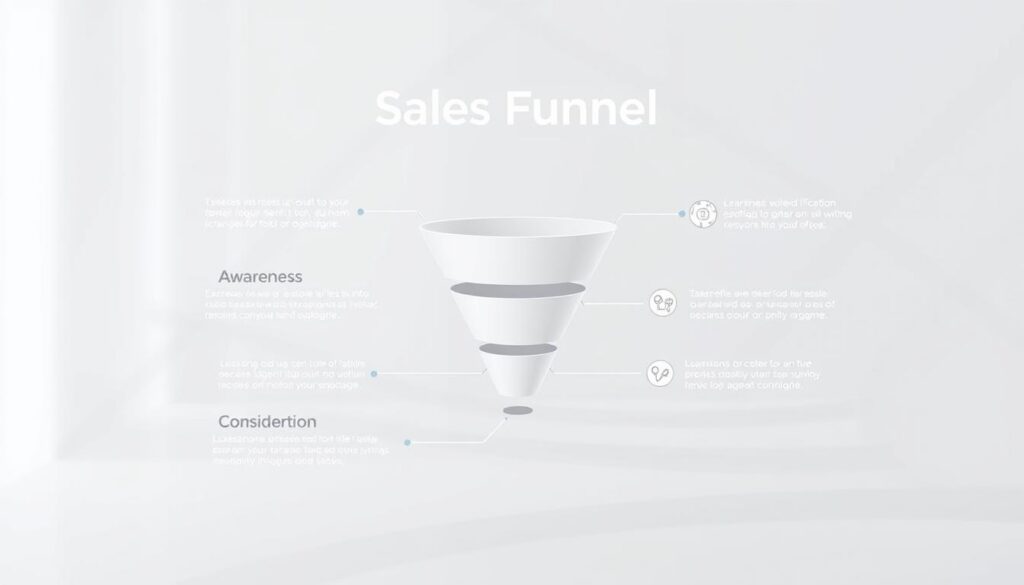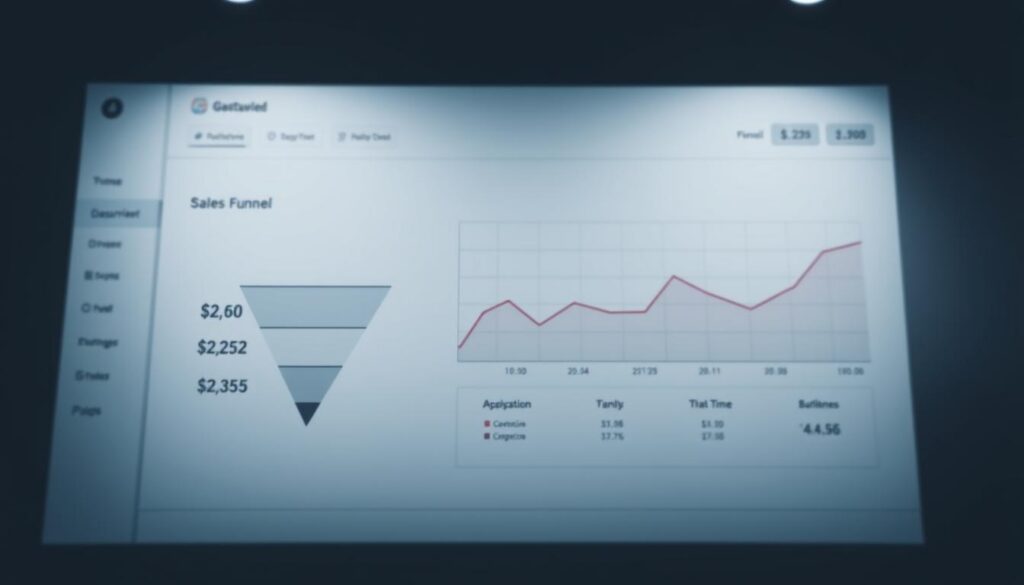In today’s fast-paced market, companies are always looking to better their marketing and boost sales. With automated GTM (Google Tag Manager) sales funnel tracking, they find a powerful tool. It helps oversee customer steps from interest to purchase, using Google Tag Manager for better analytics.
This method offers deep insights and supports choices that lift sales.
Key Takeaways
- Automated GTM sales funnel tracking simplifies data collection and analysis.
- Google Tag Manager offers robust tools for optimizing sales strategies.
- Effective tracking automation leads to improved conversion rates.
- Monitoring customer interactions is essential for a successful sales funnel.
- Data-driven insights can enhance overall marketing effectiveness.
Introduction to Automated GTM Sales Funnel Tracking
Today’s marketers need to understand Google Tag Manager well. It lets them set up various tracking tags easily, without much technical knowledge. With it, businesses can track how users interact across platforms. This improves how they collect data.
What is Google Tag Manager (GTM)?
Google Tag Manager is a powerful tool that helps marketers keep an eye on website visitors’ actions. It automates the process of adding tracking tags, making it easier to follow sales funnels. This means businesses can change their ads fast, using fresh data.
The Importance of Sales Funnel Tracking
Knowing how to track sales funnels is key to better understanding customer paths. It shows marketers what’s working and what’s not. With this knowledge, companies can decide how to improve what they offer and their ad tactics.
Benefits of Automation in Tracking
Automating the tracking of sales funnels has many pluses. It cuts down on mistakes and lets businesses respond quickly to how users behave. This makes spending on ads more efficient. To find out how to automate your GTM tasks, check this link. Automation helps firms reach out better to the people they want to buy their products.
Key Components of a Sales Funnel
It’s important to know the main parts of a sales funnel for turning leads into customers. The stages of the sales funnel help guide potential buyers on their path. Specific measures to track performance are also key. Using automation and tools for sales funnel analytics can greatly improve this process.
Stages of the Sales Funnel
The sales funnel has different stages to organize contacts. These stages are Awareness, Interest, Evaluation, Engagement, Action, and Retention. Each stage is important for creating marketing and sales plans. Companies can customize their messages based on where the buyer is in their journey.
Metrics to Monitor in Each Stage
Watching the right metrics at every stage is crucial. It helps understand customer behavior and make the buying journey better. Key metrics include conversion rates, leads generated, and dropout rates. By watching these metrics, businesses can tweak their plans to meet customer needs and make the funnel more effective.
Tools to Enhance Tracking Efficiency
Companies should use tools to make tracking easier. Popular options include Google Analytics, HubSpot, and Salesforce. These tools help with sales funnel analytics automation. They let businesses collect and analyze key data easily. Using these tools not only makes tracking better but also helps create targeted marketing strategies.

By using the right metrics and tools, firms can improve their strategies throughout the sales funnel. For deeper insights, check out how to maximize your sales funnel analytics for business growth.
Setting Up Automated GTM for Sales Funnels
An automated GTM setup helps marketers track their sales funnel smoothly. It involves key steps for accurate user interaction tracking. Following a detailed GTM setup guide improves tracking data quality.
Step-by-Step Setup Guide
First, create an account on Google Tag Manager. Then, add the GTM container code to your website. It’s important to set up tags for actions like form fills, and purchases.
After that, set triggers to correctly capture user actions.
Common Pitfalls to Avoid
Knowing common tracking pitfalls saves time and effort. Incorrect tag setups and missed triggers lead to incomplete data. Always test tags before they go live to avoid reporting errors.
Make sure to check that all tags work and look for any errors regularly.
Best Practices for Accurate Tracking
Accurate tracking with automated GTM setups is key. Regularly check your tags and triggers to keep your data accurate. Use clear tagging conventions and test in a dedicated environment to keep tracking reliable.
| Step | Description | Common Issues |
|---|---|---|
| Account Creation | Set up your Google Tag Manager account. | Using incorrect email addresses can lead to access issues. |
| Container Code Installation | Add the GTM container code to your website’s header. | Forgetting to place the code can result in no data being captured. |
| Tag Setup | Create tags for key actions in the sales funnel. | Improperly configured tags may not fire. |
| Trigger Configuration | Set triggers for tag activations based on user actions. | Missing triggers can cause significant data gaps. |
| Testing | Use the preview mode in GTM to validate setups. | Neglecting testing can result in unnoticed errors. |
Analyzing Data from Your Sales Funnel
Understanding your sales funnel data is key to a successful business. It helps you see how customers move through your sales journey. This knowledge is vital for making your marketing better. When you know what works, you can make more sales.
Interpreting Key Performance Indicators (KPIs)
It’s important to know how your sales funnel is doing. Looking at things like conversion rates and customer value tells you a lot. This info helps you decide where changes are needed to reach your goals.
Using Data to Optimize Marketing Strategies
Good use of data can improve your marketing plans. It helps find out which marketing paths are most profitable. This leads to smarter spending and better use of resources. By focusing on what customers need, your marketing will match what they want.
Leveraging Insights for Better Conversion Rates
Using data insights can really boost your conversion rates. Noticing customer trends helps you target your marketing better. Finding where people leave your funnel lets you fix issues. This makes a smoother customer journey, leading to more sales.

Integrating GTM with Other Marketing Tools
Using GTM boosts marketing efforts by linking key monitoring tools. We will discuss how to merge GTM with major platforms to better track activities.
Connecting GTM with Google Analytics
GTM and Google Analytics work together to improve site insight. This combo helps see how users interact on various channels. It shows trends and user actions, offering data to guide marketing choices.
Utilizing CRM Systems for Enhanced Tracking
Linking GTM with CRM systems betters understanding of customer paths. This connection brings vital details on how people engage with content. It leads to better, more personal marketing. For more on CRM systems and mixing them with other tools, check out this resource.
Automation with Email Marketing Platforms
Combining GTM with email marketing measures engagement well. It shows deep details on email campaign reactions. This insight aids in refining marketing moves, boosting sales, and keeping customers.
Future Trends in Automated Tracking
The digital marketing world is changing fast, and tracking is leading the way. Businesses want to make their marketing better and more effective. They are looking at new tech in sales funnel tracking to help them do this. Things like real-time data analytics, better ways to understand where sales come from, and tracking across different platforms will help marketers really understand their customers. This change is not just about better numbers. It’s about really changing how we connect with people who are interested in what we have to say.
AI is a big player in these changes, helping marketers to use machine learning to guess what customers will do next and improve their campaigns. AI looks at lots of data to find patterns. This helps create marketing plans that really speak to different types of customers. As these smart models get more used in tracking how people move through the sales funnel, things like personalization and working smarter will become key. This is changing how businesses plan their marketing in big ways.
To keep up with the competition, businesses need to get ready for new ways of looking at digital marketing data. They need to invest in strong tracking systems and always be ready to change. By getting the hang of these new tracking trends, companies can use new tech to make their sales better and make customers happier. Stepping into a future where data drives our marketing decisions will definitely take our marketing plans to the next level.
FAQ
What is the primary purpose of Google Tag Manager (GTM) in sales funnel tracking?
Google Tag Manager helps marketers easily add and update website tags. This includes web analytics, tracking, and more, without complex code work. It streamlines collecting data for better sales analysis.
How can automated GTM sales funnel tracking enhance my marketing efforts?
With automated GTM tracking, you get detailed info on how users interact with your site. This helps fine-tune your marketing strategies. And it improves your chances of turning visitors into buyers.
What are the key stages of a sales funnel?
A sales funnel has stages like Awareness, Interest, Desire, and Action, known as AIDA. They represent different buyer journey parts. These stages help shape your marketing and sales approach.
What are some common metrics to monitor in a sales funnel?
Keep an eye on conversion rates, the value a customer brings over time, and how well different sources bring in leads. These metrics show how well your sales funnel works and where to improve.
How do I set up GTM for tracking my sales funnel effectively?
Start by creating a GTM account and adding its code to your site. Set up tags for key actions like forms being filled out or items bought. Also, make triggers to accurately collect data.
What challenges might I face during the GTM setup process?
You might set up tags wrongly, mess up trigger settings, or not test enough. These mistakes can mess up data collection. It’s important to check everything is right for reliable data.
Why is it beneficial to integrate GTM with Google Analytics?
Linking GTM with Google Analytics lets you track website visits better. You’ll understand how users behave and adjust your campaigns based on their actions across various platforms.
How is technology influencing sales funnel tracking?
New tech like AI and predictive analytics is changing how we track sales funnels. It allows more personal and automatic marketing. This makes marketing strategies work better.
Can I use GTM to track multiple marketing channels?
Yes, GTM can track various platforms and marketing channels. This lets you oversee automated marketing funnels easily. And it improves how you collect data.


